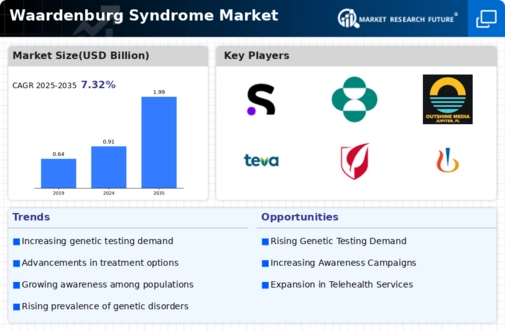Increased Research Funding
Increased funding for research into genetic disorders, including Waardenburg Syndrome, is a critical driver for the Waardenburg Syndrome Market. Government and private organizations are recognizing the importance of understanding genetic conditions, leading to a rise in grants and financial support for research initiatives. This influx of funding is expected to accelerate the pace of discovery regarding the underlying mechanisms of Waardenburg Syndrome, potentially leading to novel therapeutic options. Furthermore, as research progresses, it may uncover additional aspects of the syndrome that require attention, thereby expanding the market for treatments and interventions. The commitment to advancing knowledge in this field suggests a promising future for the Waardenburg Syndrome Market, with the potential for groundbreaking developments.
Advancements in Genetic Testing
Advancements in genetic testing technologies are significantly influencing the Waardenburg Syndrome Market. The development of next-generation sequencing and other innovative diagnostic tools has made it easier to identify genetic mutations associated with Waardenburg Syndrome. These advancements not only facilitate early diagnosis but also enable personalized treatment approaches, which are becoming increasingly important in modern medicine. As genetic testing becomes more accessible and affordable, it is anticipated that more individuals will seek testing, leading to an increase in diagnosed cases. This surge in demand for genetic testing services is likely to drive growth in the Waardenburg Syndrome Market, as healthcare providers and researchers focus on developing targeted therapies based on genetic profiles.
Growing Patient Advocacy Groups
The emergence and growth of patient advocacy groups dedicated to Waardenburg Syndrome are playing a pivotal role in shaping the Waardenburg Syndrome Market. These organizations are instrumental in raising awareness about the condition, providing support to affected individuals and families, and advocating for research funding. Their efforts contribute to a more informed public and healthcare community, which can lead to earlier diagnoses and improved treatment options. As these groups continue to expand their reach and influence, they may drive demand for specific therapies and services tailored to the needs of patients with Waardenburg Syndrome. This advocacy not only enhances the visibility of the condition but also fosters collaboration among stakeholders in the Waardenburg Syndrome Market, potentially leading to innovative solutions.
Rising Incidence of Waardenburg Syndrome
The increasing incidence of Waardenburg Syndrome is a notable driver in the Waardenburg Syndrome Market. Recent studies indicate that the prevalence of this genetic disorder may be higher than previously estimated, affecting approximately 1 in 40,000 individuals. This rise in incidence is likely attributed to enhanced diagnostic capabilities and greater awareness among healthcare professionals. As more cases are identified, the demand for effective treatment options and management strategies is expected to grow. This trend suggests a burgeoning market for therapies and interventions tailored to individuals with Waardenburg Syndrome, thereby stimulating investment and research in this area. Consequently, stakeholders in the Waardenburg Syndrome Market may find opportunities for innovation and development of targeted therapies that address the unique needs of this patient population.
Integration of Telemedicine in Care Delivery
The integration of telemedicine into healthcare delivery is emerging as a significant driver in the Waardenburg Syndrome Market. Telemedicine offers a convenient and efficient way for patients to access specialized care, particularly for those living in remote or underserved areas. This mode of care delivery is particularly beneficial for individuals with Waardenburg Syndrome, who may require ongoing monitoring and management. As telemedicine continues to gain traction, it is likely to enhance patient engagement and adherence to treatment plans, ultimately improving health outcomes. The growing acceptance of telehealth services may also lead to increased demand for educational resources and support services within the Waardenburg Syndrome Market, as patients seek to better understand their condition and treatment options.

















Leave a Comment